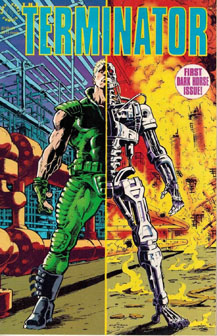As Now Comics, which would go bankrupt in 1991, wrapped up its run on “Terminator,” the license was quickly snatched up by Dark Horse Comics – so quickly that its first two issues of “Tempest”overlap with the final two issues from Now (August and September 1990). While several other companies would hold the license in the years ahead, Dark Horse – in its three stints with the license – would produce by far the most “Terminator” comics.
The four-issue “Tempest” is a promising start, featuring smart scripting from John Arcudi and – even more notably – first-class art from Chris Warner and Paul Guinan. Whereas the Now comics rarely varied its panel size, Dark Horse features vibrant and dynamic panels: what is traditionally thought of as good comic-book layouts.
“Tempest” is the first comic set pre-Judgment Day rather than post-JD. While “Tempest” contradicts the specifics of time travel and the TDEs (time-displacement equipment) of “All My Future’s Past,” that actually allows us to think about the supposed continuity gaffes and find in-universe explanations. It can be done, as I’ll explain below.
CHARACTERS
John Connor: Not in the story. He’s in his mother’s womb during this time.
Sarah Connor: Not in the story. She’s pregnant with John during this time.
Kyle Reese: He’s dead, as per the events of the movie, and is a couple decades away from being born.
Five resistance fighters: A quintet travels from 2029 to 1984 to wipe out Cyberdyne.
Dr. Hollister: The head of Cyberdyne’s top-secret Project Bellerophon serves the same role Miles Dyson will in “T2,” but he’s not as noble as Dyson. He has no problem with four Terminators protecting him as he develops artificial intelligence. Hollister is in it for the money.
TERMINATORS
Four (or so it seems) T-800s: This quartet travels from 2029 to 1984 to protect Cyberdyne’s Dr. Hollister from the five resistance fighters who aim to kill him. In Issue 4 we learn that the T-800 series debuted in 2009 and “it (takes) over a year to cultivate human clone tissue over the Terminator chasis.” This bloody process would later be seen in “The Sarah Connor Chronicles.”
I825.M: This particular member of the quartet (to be dubbed Dudley in future stories) is actually a human with cybernetic parts. Calling himself a “survivor,” he served Skynet as a surgeon for T-800s in the Future War, but switches sides to humanity in 1984. He’s a precursor to Marcus Wright of “Terminator Salvation.”
The wreckage of the first movie’s endoskeleton: The police possess the entire (albeit flattened by a metal press) endoskeleton – not just the chip and arm — and Hollister has been allowed to look at the wreckage and take copious notes.
CONTINUITY
“Tempest” is the first-published comic to take place in the aftermath of the 1984 portion of the movie. Arcudi’s text says it takes place in 1990 (at least on the early printings), but Dark Horse later changed it to 1984, according to the “Terminator” Wiki.

In addition to predicting the “Sarah Connor Chronicles’ ” clone-tissue cultivation process and “Terminator Salvation’s” Marcus Wright, the prescient Arcudi gives us one of the subplots of “T2” a year before its release. But instead of Sarah trying to destroy Cyberdyne, five resistance fighters time-jump from 2029 to do so.
Arcudi’s chronicle of Skynet’s TDE platforms is different from Chuck Dixon’s in “All My Future’s Past.” But since the two titles came out at exactly the same time, I can’t blame either one for contradicting the other.
Dixon’s interpretation makes a bit more logical sense. In “All My Future’s Past,” we see the T-800 use one platform (which is promptly destroyed), then Kyle uses another platform a klick away. This accounts for the different locations their time bubbles appear in L.A.
“Tempest” reimagines those two TDEs as “prototypes” located at Skynet’s Master Control, which was then destroyed by the resistance. We generally think of Skynet’s headquarters as being in the Rocky Mountains, not L.A., but one could argue that the TDE fortress of “All My Future’s Past” was the “Master Control” for the L.A. portion of the war.
Three months later, the resistance comes upon this third, superior TDE – also in L.A. – which can send back a bunch of Terminators (or people) at once.
While we usually think of time travel in the dimension of time, “Tempest” also includes a minor glitch regarding time travel in the dimension of space. As noted, “All My Future’s Past” logically placed the TDE bubbles for the T-800 and Kyle a klick apart. But “Tempest” has the Terminators follow the resistance through the SAME TDE programmed for the SAME time.
Logically, this means: 1) The two groups will appear at the same time in the same place, either in a comfortable group or hideously fused together like the Ripley clones in “Alien Resurrection,” 2) The time bubbles will bounce off each other slightly, so the two groups emerge near each other but not directly on top of each other, or 3) Because the TDEs trade a bubble of reality from one time for that of another time, the Terminators will replace the resistance fighters, thus returning the resistance fighters to the TDE platform.
Option 2 best describes what happens in “Tempest,” but rather than a slight separation in space, the two groups emerge in different parts of L.A. Editor Diana Schutz responds to a letter writer in Issue 4 with:
“The Terminators DID arrive at the same time as our soldiers, just not at the same place. The TDE was damaged, after all, and besides, one would expect that a failsafe mechanism would be built in to prevent two objects from arriving at both the same time AND the same place.”
In another continuity hiccup, in Issue 4 we learn that the T-800s debuted in 2009. This contradicts “All My Future’s Past,” where T-800s were brand-new in 2029. The real-world explanation for the contradiction is that Now and Dark Horse did not compare notes. But the in-universe explanation might be …
TIME TRAVEL
As I see it, the in-universe explanation for why the T-800s are created in 2029 in “All My Future’s Past” and in 2009 in “Tempest” is that the former occurred on an older timeline than the latter. If each instance of time travel instantly creates a new timeline, there have been four distinct timelines in the saga by this point: The one created by the T-800 (the movie), the one created by Kyle (the movie), the one created by the resistance (“Tempest”) and the one created by the Terminators (“Tempest”).
Indeed, it makes sense that the T-800s would debut earlier on a “worse” timeline (for example, one where the T-800 appeared in 1984 but Kyle did not, and thus the T-800 killed Sarah) but later on a “better” timeline (for example, one where Kyle stopped the T-800 from killing Sarah).
In another example of differing timelines, the resistance soldier named Mary notes that “Project Bellerophon will perfect artificial intelligence sometime before 1993.” This was the history in Mary’s future, but it doesn’t sync with “T2,” where the name “Bellerophon” is not used and where Cyberdyne has not perfected A.I. by 1995, let alone ’93.
Each instance of time travel immediately creates a new, slightly different future. As such, while some fans think “Terminator” continuity is a headache, in my view the instances of time travel actually allow for a tidy explanation of “the events happened on different timelines.”

